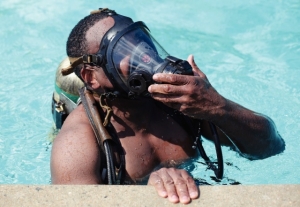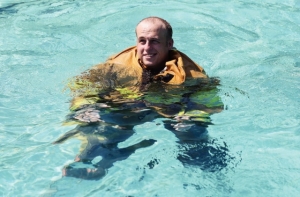Testing the waters
By Kirsten Ballard
Published in News on August 18, 2015 1:46 PM

News-Argus/MELISSA KEY
Thurman Shackleford comes up for air after practicing using an oxygen tank underwater during firefighter water safety training at Peacock Pool on Thursday.

News-Argus/MELISSA KEY
Firefighter Zachary Brooks smiles as he realizes how buoyant his suit becomes when submerged in the water.
The most important thing is not to panic.
Andrew Cabrera took a deep breath and stepped into the pool.
He had 75 pounds strapped on his body. He might sink like a stone.
He stayed calm.
He had a job to do.
Cabrera was one of the many firefighters at Peacock Pool on Thursday afternoon taking water rescue training.
Instructor and Goldsboro firefighter Brandon Jones says the No. 1 killer of rescue workers is water.
"We're trying to build awareness," he said. "We hope not (to use this) but you have areas in every district that are prone to flooding."
In events like flash floods, he wants the men to be prepared to be in moving water with full turnout gear on.
"It can sweep you off your feet," he said.
Another threat is flooded basements or if a firefighter accidentally steps in a pool at a rescue.
"We don't want a situation where you have to rescue the rescuer," Jones said.
With the boots, suits and tools, the gear weighs around 75 pounds, but when the suit gets wet, it becomes waterlogged.
"The first impression is that you're sinking and fast," Jones said.
Instead, the suits and air tank float. It is difficult to swim, but it will not drag the man to the bottom.
When Zachary Brooks jumped into the deep end in the suit, he says it was ridiculous.
"(The suit) is at least 10 times heavier," he said.
But his head never went under because of the buoyancy of the suit.
David Thompson has been teaching the class for six years. He is an engineer with Wilson Fire and Rescue.
"We're doing some myth busting today," he said.
He stood on the side of the pool watching as man after man jumped in, in turn out gear and chest waders.
"The water makes everything buoyant," he explained.
The respirators and air tanks, while not scuba gear, will continue to function in water.
"It's weird when you breathe in," Cabrera said. "It doesn't let water in. I didn't expect that."
The instruction takes part in the classroom and then in simulated scenarios in the pool and on the Neuse River.
In the pool, the men do a 300-meter swim, a 100-meter swim with a life vest, 10-minute tread and a combative rescue -- a rescue involving a victim who is scared and panicked and fighting off the rescuer.
While on the Neuse, the men learn throw bag techniques.
"We want to make sure everyone can self-rescue," Thompson said.
